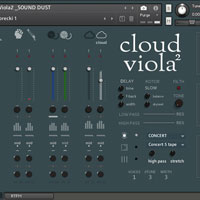The Viola da Gamba is a 6-stringed bowed and fretted instrument that first appeared in Spain in the mid to late 15th century and was most popular in the Renaissance and Baroque periods. Cinesamples' Viola da Gamba was recorded at the MGM Scoring Stage in Los Angeles.
The Instrument
This instrument is strung with 6 gut strings that are tuned to (relative to Kontakt): D1, G1, C2, E2, A2, and D3.
Viols are fretted in a manner similar to early guitars or lutes, by means of movable wrapped-around and tied-on gut frets. The movable nature of the tied-on frets permits the viol player to make adjustments to the tempering of the instrument. On this particular instrument, the frets only extend 7 semi-tones on each string.
The Patches
THE ARTICULATIONS PATCH
The main articulations patch contains sustains, True Legato, staccato, chug, sforzando, pizzicato (via the red keyswitch), with an optional accent overlay.
TRUE LEGATO
What is True Legato? We sampled all of the intervallic leaps throughout the ranges, upwards and downwards, for each instrument. When you play a True Legato patch, it instantly analyzes the intervals you play, and then plays the appropriate transitional leap between the notes. The result is a smooth and realistic legato performance.
VIBRATO CROSSFADE
CC02 will crossfade into vibrato on notes D3 thru D4. Vibrato is stable only on non-fretted notes on the Viola da Gamba.
THE DRONES PATCH
The Drones patch contains Measured Sustains, Trills, Tremolos, Sul Ponticello Drones, and Open Strings. By default these articulations are chosen using keyswitches.
THE SPLIT KEYBOARD PATCH
The Split Keyboard patch is essentially a combination of the Drones patch and the main Articulations patch. The lower octaves keyswitch between Measured Sustains, Tremolos, and Sul Ponticello Drones, while the upper octaves play sustains and legato with the pedal down and Staccato with the pedal up. The two halves of the keyboard can be played together or independently.
THE INFINITE BOW
Most patches contain a green, non-latching Keyswitch. Hold it down before transitioning to a note you want played with an infinite sustain. This is understandably an unnatural occurrence, but it provides the necessary bow length needed in slower tempi.



